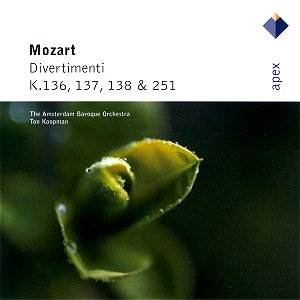The
terms serenade, nocturne, cassation and divertimento were used
more or less interchangeably by Mozart and his contemporaries.
All were taken to mean music of a lightweight, entertaining nature,
suitable for use at social functions. Mozart, however, considerably
broadened the expectations of what such works might consist of,
composing masterpieces like the Serenade for 13 wind instruments,
K.375, or the late great Divertimento in Bb for string trio.
In
any case, if we could time-travel back to the 18th
century, I think we might be surprised just how much attention
was paid to so-called background music. Nowadays, at functions
where there is live music at a party or reception, the tendency
is for guests to shout loudly above it, and it’s regarded as slightly
bad form to show the slightest interest! In Mozart’s day, the
music would be a major source of comment and discussion, just
like the food and drink, the company and so forth.
Hence
these slight works are charming and impeccably crafted. Yes, they
are mostly the sort of stuff Mozart could compose in his sleep
(almost literally), but they still have the capacity to surprise
and delight. The first three on this disc are all genuinely early
pieces, scored for strings alone, while the fourth one is from
a little later, and includes parts for an oboe and two horns.
There
is a freshness about K.136 in D that is like biting into a crisp
green apple. The central Andante has an easy lyricism that
is profoundly relaxing, while the finale is full of effervescent
humour. K.137 is not so attractive, but is extremely interesting
in stylistic terms. An awful lot of fuss is always made of the
opening chord of Beethoven’s first symphony, whose first chord
immediately points away from the tonic key, C major. Well, Beethoven
was 29 when he composed that symphony in 1799; here is the 16-year-old
Mozart starting a piece in Bb major, with no preamble, by going
straight to C minor, and then on to D minor, before settling in
the home key – and this twenty-seven years before the Beethoven
- Ludwig, eat your heart out! I have no doubt that a few eyebrows
were raised when this divertimento was first played.
The
rest of K.137 is more mundane, as is K.138 in F, though its first
movement is charming, and contains a little thematic ‘pre-echo’
of the equivalent movement in Eine Kleine Nachtmusik (Track
7, 0:53]. The slow movement finds the young composer experimenting
with the considerable expressive possibilities of dissonance,
and doing it to great effect.
The
playing of the Amsterdam Baroque Orchestra in all of these pieces
is a delight. Clean as a whistle, impeccably stylish, yet with
none of that impoverished tone we sometimes get in ‘period’ performances.
It’s full of character, with many tiny points of contrast and
detail brought out clearly without distorting the texture. Koopman
doesn’t get in the way, just allows his excellent strings to get
on with it – hence the music flows naturally.
I
confess I like the K.251 Divertimento much less than the earlier
three. It is attractive enough, but seems very routine and rather
humourless. The general feeling of monotony is not helped by the
scarcity of modulation; five out of the six movements are firmly
rooted in D, and excursions to anything other than the most closely
related keys are few and far between. This is particularly noticeable
in the tedious Rondeau fifth movement and its successor,
the inconsequential little Marcia aale francese. (Is there
a touch of Mozartian humour in the use of French for ‘Rondeau’
instead of the more normal ‘Rondo’, then the use of Italian for
the last movement, whose title means ‘March in French style’?!
I think so.) The whole piece is about as inspiration-free as Mozart
could get; which, annoyingly, means that it’s still pretty terrific
for this genre of piece in this era by a 20-year-old. I’m judging
it by Mozart’s own standards.
Koopman
opts for solo strings in this, which is generally a good idea,
and allows the two horns and oboe to sing out easily. Some listeners,
however, may find the solo double-bass just a little too prominent
– it has a quite percussive edge sometimes, which is not at all
unpleasant, but a touch surprising nonetheless. (No slur on the
excellent bass playing, more likely a problem for the recording
team).
This
is an ideal issue for these hot summer nights; Eine Kleine
Mozart to keep you cool with highly efficient musical air-conditioning.
Gwyn
Parry-Jones
